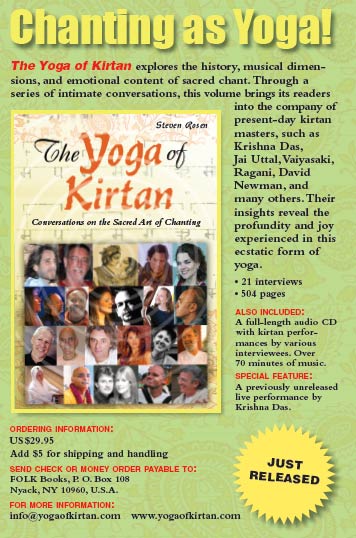The Yoga of Kirtan: A Conversation with Satyaraja Dasa
By Vyenkata Bhatta Dasa | May 30, 2008

Author and practicing Vaishnava Satyaraja Dasa (Steven J. Rosen) releases his latest book, The Yoga of Kirtan: Conversations on the Sacred Art of Chanting, in early June. He took some time out to chat with ISKCON News staff member Vyenkata Bhatta Dasa about the new book and why kirtan is about transcending barriers.
VBD: The Yoga of Kirtan: Conversations on the Sacred Art of Chanting. The book seems like something of a departure for you — it’s not your usual scholarly enterprise but rather a more accessible survey of kirtan culture and lore. So, I guess my first question would be this: Who is your intended audience, and what does your book offer to that audience?
SD: Although the book is not scholarly per se, it does offer much on the roots of kirtan, and a lot of detailed information comes out in the conversations and in my appended essays. I would say that readers will get a well-rounded understanding of kirtan and its philosophical background by reading this book.
The audience? My usual audience — consisting of ISKCON, ISKCON well-wishers, Indophiles of all stripes and scholars and students — will certainly get a lot out of the book. But this work breaks down barriers, if you will, because all differences melt away in the midst of a good kirtan. The book shows kirtan as a unifying principle, as something that transcends divisiveness and the particulars of a given religious tradition.
Also, I’ve used a style of writing and language that opens the teaching of kirtan to numerous audiences. For example, I couch much of my dialogue in yoga terminology, so that popular yoga groups and New Age devotees might benefit from the contents. This was important to me, especially since kirtan has now found a home in yoga ashrams in the West. Once silent meditation halls now vibrate with kirtan — Western yogis now incorporate sacred chant into their practice; it’s become quite a Western phenomenon, with grammy-winning CDs by yogic chanters.
VBD: This seems to be quite an ambitious project in so many ways — a 500-page book with a music CD attached. This will be the definitive book on kirtan.
SD: That’s the plan. I wanted to put together a readable book that explains the basics of kirtan, allowing readers entrance into the history, emotion, and culture of sacred chant. It’s basically a book of interviews with the people who have most popularized kirtan in the Western world. So one can benefit from their realizations and perspectives. I’ve also included a number of essays of my own, i.e., an elaborate section on the identity of Chaitanya Mahaprabhu; the actual meaning of OM; and so on. Devotees will appreciate certain recurring themes in the book, too: Srila Prabhupada’s contribution in bringing the chanting West; the glories of the maha-mantra, etc. The important thing is this: Overall, readers walk away with essential Vaishnava siddhanta, or appropriate philosophical conclusions.
VBD: Yes, but I must say: One of the striking features of this book is the variety of perspectives. I notice your interviews not only consist of ISKCON devotees, like Bhakti Charu Swami, Mother Yamuna, Agnideva, Dravida, Sri Prahlad, Karnamrita, and others, but of those who are outside the movement.
SD: That’s right. The point is to show that kirtan transcends the particulars of narrow boundaries and sectarianism. Actually, anyone who embraces the Holy Name will get embraced by the Name in return. Krishna is all merciful, and that comes out in the book. Anyone can chant His names, and they will certainly benefit from it.
That being said, I go through great pains to show that mantras traditionally come down in certain lineages, and that the full fruit of the mantra ripens in this environment.
Still, kirtan is a universal practice and can’t be limited by a particular affiliation or perspective. Actually, in the book, among the 21 interviews — which all serve the book’s overall purpose, in one way or another — I have one interview with a popular Sikh kirtaniya, and another with a Jewish kirtaniya who does “Kabbalistic Kirtan.” Amazingly, their words and thoughts echo Vaishnava masters, showing that kirtan is not really about context, culture, or language — it’s about a pure heart calling out to the Divine. It’s about the soul crying out for her Maker. What we are talking about here is “sonic spirituality,” which is a part of all religious traditions.
To Order:
Check or money order for $29.95 (plus $5 for shipping and handling).
Payable to: “FOLK Books.”
Mail to: FOLK Books, P.O. Box 108, Nyack, NY 10960 USA.













